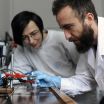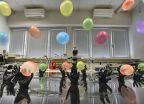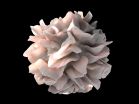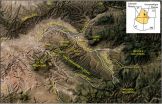(Press-News.org) Nanoparticles of various types can be quickly and permanently bonded to a solid substrate, if one of the most effective methods of synthesis, click chemistry, is used for this purpose. The novel method has been presented by a team of researchers from the Institute of Physical Chemistry of the Polish Academy of Sciences, Warsaw, Poland.
A small movement of the hand, the characteristic 'click!' - and the snap fastener quickly and securely fastens our clothes. One of the newest methods of synthesis in modern chemistry, click chemistry, works on a similar basis. Here, molecules are combined to form new chemical compounds by means of chemical 'snaps'. The method has so far been used mainly for the synthesis of more complex organic compounds. Now at the Institute of Physical Chemistry of the Polish Academy of Sciences (IPC PAS) in Warsaw, Poland, they have managed to show that click chemistry chemical snaps can quickly, effectively and permanently bond much larger structures: gold nanoparticles to a glassy carbon substrate.
The main idea of click chemistry was formulated in the final years of the previous century. It was inspired by nature, among others by the large number of proteins that arise from the diverse combination of amino acids with the same bond (peptide). Chemistry according to the click method has a lot of advantages. Many reactions take place at low temperatures, in addition in a single solvent, which can often be environmentally friendly water. What's more, the yield of the reaction is high: usually approx. 80-90%. The versatility, efficiency and selectivity of click chemistry has made it very popular, especially in the synthesis of new organic compounds.
"Click chemistry is similar to building new structures with building blocks. The blocks can be various chemical compounds, what is important is for them to have matching snaps. A problem arises when they are not present. Then you have to consider whether you can somehow attach the right snaps to a given building block," says Dr. Joanna Niedzió?ka-Jönsson (IPC PAS).
The Warsaw-based chemists decided to apply click chemistry not to chemicals, as was previously the norm, but to bond nanoparticles - i.e. relatively large objects - to solid substrates.
"Usually, nanoparticles are simply deposited on the substrate and they attach to it by quite weak physical, for example electrostatic, interactions. We decided to show that with click chemistry they can be bonded to the substrate with covalent chemical bonds and thus permanently," stresses Dr. Adam Le?niewski (IPC PAS), winner of the Iuventus Plus grant from the Polish Ministry of Science and Higher Education, under which the study was carried out.
To form the bond, the researchers from the Institute of Physical Chemistry of the PAS used well-known chemical 'snap fasteners': groups of three nitrogen atoms (azides), which in the presence of a catalyst can combine with groups of carbon atoms (terminal alkynes) located at the end of other molecules. When they are connected, the two groups form stable nitrogen-carbon (triazole) rings. In this study, the azide groups were located on a glassy carbon substrate, and the terminal alkynes were introduced onto the surface of gold nanoparticles.
In earlier studies at the IPS PAS the catalyst participating in the reaction was produced chemically. Currently an electrochemical method is used for its generation, in which the role of the substrate is played by an appropriately prepared carbon electrode.
"We have managed to adjust the conditions of the whole process so that the suspension of gold nanoparticles in the solution surrounding the electrode remains stable while maintaining an appropriate concentration of copper two ions and supporting electrolyte. In this environment, the production of the right catalyst, complexes of copper one and the bonding of nanoparticles itself to the substrate is very efficient," explains PhD student Justyna Matyjewicz (IPC PAS).
Using a flow of current has significantly shortened the reaction time of the nanoparticles bonding to the substrate.
"We have been working with gold nanoparticles and carbon substrates, but our method is universal and in the future it can be used to produce substrates from other materials," emphasises Dr. Niedzió?ka-Jönsson.
Substrates produced by the Warsaw chemists are already making it easy to detect, among others, nitrites in the presence of sulphites. Sensors constructed on the basis of such substrates can be used, for example, to detect the presence of preservatives in foodstuffs. In the future, the type of click chemistry proposed by the IPC PAS researchers may find an application in the production of new, stable substrates for a variety of chemical sensors and electrodes employed in flow systems.
INFORMATION:
The Institute of Physical Chemistry of the Polish Academy of Sciences was established in 1955 as one of the first chemical institutes of the PAS. The Institute's scientific profile is strongly related to the newest global trends in the development of physical chemistry and chemical physics. Scientific research is conducted in nine scientific departments. CHEMIPAN R&D Laboratories, operating as part of the Institute, implement, produce and commercialise specialist chemicals to be used, in particular, in agriculture and pharmaceutical industry. The Institute publishes approximately 200 original research papers annually.
Clear and realistic expectations are key to successfully hiring heads of departments, say Professor Pierre-Alain Clavien, University of Zurich, and Joseph Deiss, former President of the Swiss Confederation, in a commentary in Nature magazine.
Selecting a chair for a position in clinical academic medicine is often problematic, with the diverse demands placed on the position proving a constant source of debate. Today's heads of departments are not only expected to be outstanding physicians, researchers, and teachers, but also adroit and cost-conscious managers. Finding ...
A pioneering class of drugs that target cancers with mutations in the BRCA breast cancer genes could also work against tumours with another type of genetic fault, a new study suggests.
Scientists at The Institute of Cancer Research, London, found that errors in a gene called CLBC leave cancer cells vulnerable to PARP inhibitor drugs. Around 2 per cent of all tumours have defects in CLBC.
The study, which was carried out in collaboration with colleagues in Denmark and the Czech Republic, was funded in the UK by the European Union, and was published today (Thursday) in ...
Are humans born with the ability to solve problems or is it something we learn along the way? A research group at the Department of Physics and Astronomy, Aarhus University, is working to find answers to this question.
The research group has developed a computer game called Quantum Moves, which has been played 400,000 times by ordinary people. This has provided unique and deep insight into the human brain's ability to solve problems. The game involves moving atoms around on the screen and scoring points by finding the best way to do so.
In this way, ordinary people ...
Scientists at the University of Cambridge have successfully created 'mini-lungs' using stem cells derived from skin cells of patients with cystic fibrosis, and have shown that these can be used to test potential new drugs for this debilitating lung disease.
The research is one of a number of studies that have used stem cells - the body's master cells - to grow 'organoids', 3D clusters of cells that mimic the behaviour and function of specific organs within the body. Other recent examples have been 'mini-brains' to study Alzheimer's disease and 'mini-livers' to model ...
Women who received a text message reminding them about their breast cancer screening appointment were 20 per cent more likely to attend than those who were not texted, according to a study published in the British Journal of Cancer today (Thursday)*.
Researchers, funded by the Imperial College Healthcare Charity, trialled text message reminders for women aged 47-53 years old who were invited for their first appointment for breast cancer screening.
The team compared around 450 women who were sent a text with 435 women who were not texted**. It found that 72 per cent ...
PISCATAWAY, N.J. (March 18, 2015) - New research published by Rutgers University chemists has documented significant progress confronting one of the main challenges inhibiting widespread utilization of sustainable power: Creating a cost-effective process to store energy so it can be used later.
"We have developed a compound, Ni5P4 (nickel-5 phosphide-4), that has the potential to replace platinum in two types of electrochemical cells: electrolyzers that make hydrogen by splitting water through hydrogen evolution reaction (HER) powered by electrical energy, and fuel cells ...
The number of people living with cystic fibrosis into adulthood in the UK is expected to increase dramatically - by as much as 80 per cent - by 2025, according to a Europe-wide survey, the UK end of which was led by Queen's University Belfast.
People living with cystic fibrosis have previously had low life expectancy, but improvements in treatments in the last three decades have led to an increase in survival with almost all children now living to around 40 years. In countries where reliable data exists, the average rise in the number of adults with CF is expected to be ...
A recent study published in the Journal of the American Academy of Child and Adolescent Psychiatry reports that following military parents' return from combat deployment, their children show increased visits for mental healthcare, physical injury, and child maltreatment consults, compared to children whose parents have not been deployed. The same types of healthcare visits were also found to be significantly higher for children of combat-injured parents.
Children of deployed parents are known to have increased mental healthcare needs, and be at increased risk for child ...
When cancer strikes, it may be possible for patients to fight back with their own defenses, using a strategy known as immunotherapy. According to a new study published in Nature, researchers have found a way to enhance the effects of this therapeutic approach in glioblastoma, a deadly type of brain cancer, and possibly improve patient outcomes. The research was funded by the National Institute of Neurological Disorders and Stroke (NINDS) as well as the National Cancer Institute (NCI), which are part of the National Institutes of Health.
"The promise of dendritic cell-based ...
Boulder, Colo., USA - Unaweep Canyon is a puzzling landscape -- the only canyon on Earth with two mouths. First formally documented by western explorers mapping the Colorado Territory in the 1800s, Unaweep Canyon has inspired numerous hypotheses for its origin. This new paper for Geosphere by Gerilyn S. Soreghan and colleagues brings together old and new geologic data of this region to further the hypothesis that Unaweep Canyon was formed in multiple stages.
The inner gorge originated ~300 million years ago, was buried, was then revealed about five million years ago when ...





